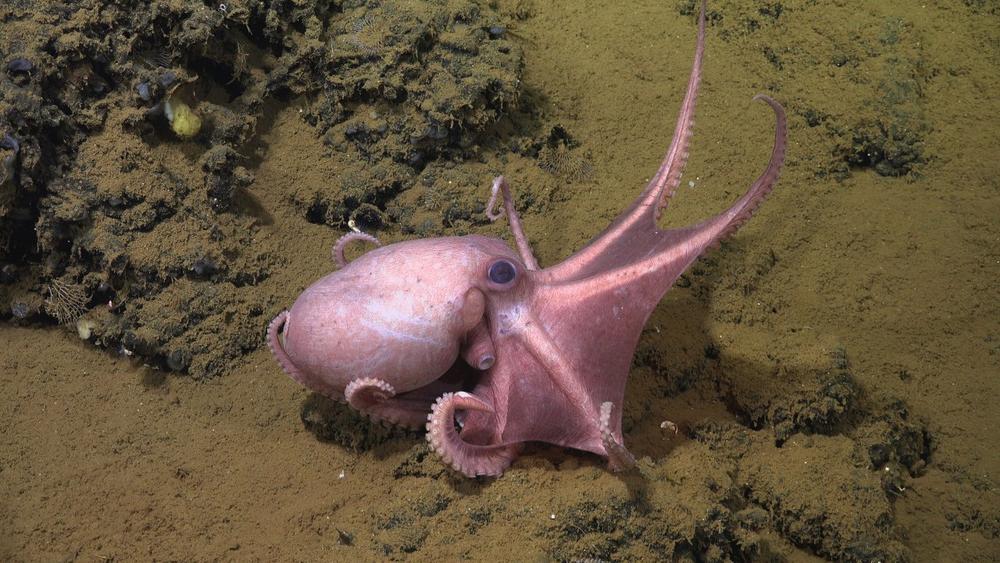A Deep-sea Octopus is the “Mollusk of the Year 2025”


The deep-sea octopus Muusoctopus received over 1,300 votes, edging out the “blue dragon” sea slug (Glaucus atlanticus), the Atlantic carrier snail (Xenophora conchyliophora), the Hawaiian black-footed limpet (Cellana exarata), and the ocean quahog (Arctica islandica). More than 4,000 mollusk fans voted in the poll. The genus Muusoctopus includes octopuses that live in the icy depths of the oceans. One of the ways they differ from their shallow-water relatives is their lack of an ink bladder – an adaptation to the darkness of the deep sea where few predators lurk.
The deep-sea octopus was nominated for the title of “Mollusk of the Year 2025” by marine biologist Fiorella Vásquez-Fallas from the University of Costa Rica. “Octopuses of the genus Muusoctopus are fascinating animals,” says Vásquez-Fallas. “It was only recently discovered that a Muusoctopus species, the ‘Dorado Octopus,’ forms huge colonies at a depth of around 3,000 meters off the coast of Costa Rica. The females of this species appear to incubate their eggs exclusively in the warm waters of hydrothermal vents – an extraordinary behavior that is revolutionizing our understanding of deep-sea ecology, reproduction, and evolution. I am delighted that Muusoctopus has been chosen as the ‘International Mollusk of the Year 2025’!”
New insights into Muusoctopus will now also be provided by the analysis of its genome, which is linked to winning the title. “We will now fully sequence the DNA of the ‘Mollusk of the Year 2025’ for the first time at Senckenberg. This will allow us to gain insights into the genetic basis for their extraordinary way of life and adaptation to thriving in the deep sea,” reports Dr. Carola Greve from the Senckenberg Research Institute and Natural History Museum Frankfurt. “Although mollusks are the second-most species-rich animal group in the world, with a fascinating diversity of forms, lifestyles, and adaptations, the genomes of comparatively few mollusk species have been fully sequenced to date. Therefore, a large gap remains in our understanding of the genomic basis for their impressive traits.”
After a jury of researchers from Senckenberg and Unitas Malacologica selected five finalist species from more than 30 suggestions by the international mollusk community, all fans of snails, octopuses, and their ilk could vote online for their favorite from March 3 to 31. With 1,337 votes, Muusoctopus received around a third of the total of 4,005 votes cast. The “blue dragon” sea slug (Glaucus atlanticus) came in a close second, followed by the ocean quahog (Arctica islandica), the Atlantic carrier snail (Xenophora conchyliophora), and the Hawaiian black-footed limpet (Cellana exarata).
“We are absolutely thrilled that so many mollusk fans from all over the world took part in the campaign again this year! A big thank-you to all the researchers who nominated such fantastic species for the competition and to everyone who voted for their favorite,” says a delighted Prof. Dr. Julia Sigwart, Head of the Malacology section at the Senckenberg Research Institute and Natural History Museum Frankfurt. “Together, we are thus contributing to raising public awareness for these extraordinary and often underestimated animals. In the future, we will continue our work towards a better understanding of mollusks and their long-term protection.”
Website with brief portraits of the finalist species:
The Senckenberg Gesellschaft für Naturforschung (Senckenberg Nature Society), a member institution of the Leibniz Association, has studied the “Earth System” on a global scale for over 200 years – in the past, in the present, and with predictions for the future. We conduct integrative “geobiodiversity research” with the goal of understanding nature with its infinite diversity, so we can preserve it for future generations and use it in a sustainable fashion. In addition, Senckenberg presents its research results in a variety of ways, first and foremost in its three natural history museums in Frankfurt, Görlitz, and Dresden. The Senckenberg natural history museums are places of learning and wonder and serve as open platforms for a democratic dialogue – inclusive, participative, and international. For additional information, visit www.senckenberg.de.
Senckenberg – Leibniz Institution for Biodiversity and Earth System Research // Senckenberg Gesellschaft für Naturforschung
Senckenberganlage 25
60325 Frankfurt
Telefon: +49 (69) 7542-0
Telefax: +49 (69) 746238
http://www.senckenberg.de
![]()